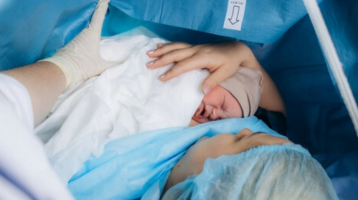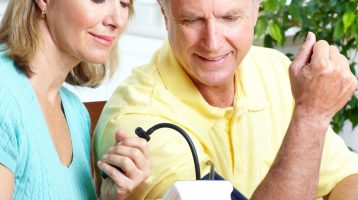Basic Care
Vitamins, trace elements and minerals are essential for our bodies to function well. No matter whether it is for healthy metabolism and organs, defense against pathogens, or physical and mental activity would not be possible for our bodies without all of these valuable substances. A poor lifestyle, substantial hormone changes during menopause and advanced aging lead to a drop in micronutrient levels. The result for females can be in the form of illnesses or deficiency symptoms and the impact can be especially great during menopause. The science behind chronobiology has proven that the body needs certain substances at certain times of day. Some work best in the morning; others reach their greatest potential in the evening. Some are even needed by the body throughout the entire day. Individual nutrients can be taken at the same time as they can complete and even strengthen each other’s impact, but others need to be taken at different times.
A prescription that is administered according to chronobiology makes vitamins, minerals, trace elements and plant extracts available each at the correct time of day so that they can work together optimally and ensure that they are ideally absorbed, unlocked and used by the body. Additionally, the combination of active ingredients must be customized to fit the specific needs of the female metabolism. Substances for morning consumption have a vitalizing effect and need to increase energy and improve mental elasticity, whereas evening substances need to support reparative processes and slow and calm down the metabolism.
Substances for the Morning (Activating Effect):
- Beta-Carotene
- Lutein
- Lycopene
- Choline
- Inositol
- Citrus-Bioflavonoide
- Calcium
- Magnesium
- Manganese
- Boron
- Chromium
- Selenium
- Molybdenum
- Iodine
- Dong-Quai
- Damiana
- Vitamin A
- Vitamin B6
- Vitamin C
- Vitamin E
- Vitamin K
Substances for the Evening (Regenerative Effect):
- Soy-Isoflavonoide
- Niacinamide
- Pantothenic Acid
- Biotin
- Folic Acid
- PABA
- Potassium
- Zinc
- Iron
- Copper
- Vitex-agnus-castus
- Glycyrrhiza-glabra
- Rhodymenia-dulce
- Vitamin B1
- Vitamin B2
- Vitamin B12
Female Fertility
Infertility affects many people. On average, one in six couples have problems conceiving on the first try. In two thirds of the cases, the woman is responsible for the problems. There are a number of negative factors which can impair female fertility. Next to increasing age in which the quality of the egg cells decreases, irregular ovulation, damaged follicles, inflammation and other illnesses can also be responsible for fertility problems. A woman in her early 20s is the most fertile and fertility reduces drastically beginning in the mid-30s. After 40 the chances to become pregnant is at a mere five percent!
Selected vitamins, minerals, amino acids and enzymes which are administered at the correct time of day can support female fertility by using activating substances in the morning and regenerative substances in the evening. These active substances function to stabilize the nervous system and ensure the improved function of reproductive organs. An optimal chronobiological supplement supports the female body prior to fertilization in order to create optimal conditions. With success, three out of four healthy women at the age of 30 achieve pregnancy within one year, without artificial insemination or the use of drugs. Substances which affect blood flow positively are used in the morning, whereas evening substances ensure needed cell protection.
Substances for the Morning (Activating Effect):
- Myo-Inositol
- L-Arginine
- Maca
- Tomato Seed Extract (Fruitflow)
- Manganese
- Beta-Carotene
- Lutein
- Lycopene
- Vitamin A
- Vitamin B6
- Vitamin C
- Vitamin D
- Vitamin E
- Vitamin K
- Chromium
- Molybdenum
- Iodine
- Selenium
- Calcium
Substances for the Evening (Regenerative Effect):
- Folic Acid
- Q-10
- Maca
- Omega-3
- Niacinamide
- Pantothenic Acid
- Vitamin B12
- Biotin
- MCHC
- Magnesium
- Iron
- Copper
- Zinc
- Calcium
- Vitamin B1
- Vitamin B2
- Vitamin B12
Menopause and Its Impact
Plant substances that have an estrogen-like effect have long been helpful in the treatment of menopausal symptoms.
Menopause is the time period in which the female reproductive system is conclusively dismantled, leading to the loss of fertility in women. The ovaries no longer produce any progesterone or estrogen and the maturation of egg cells is discontinued. The production of the growth hormone HGH, the anti-aging hormone DHEA, pregnenolone, as well as the sleep hormone melatonin decreases. Until this phase begins, the pituitary gland releases stimulants into the blood that cause the ovaries to produce sex hormones. The increased blood flow signals to the brain that the process was successful. This leads to the stabilizing of hormones. Over the years the female body no longer produces enough sex hormones to signal this success, which means that the brain does not receive a stop signal, and the pituitary gland releases more stimulants. The result: a disturbance of the system that leads to rapid aging of the body. At the onset of menopause a woman in the Western world is on average 51 years old, with the normal range reaching from 44 to 52 years. Menopause can be divided into three different phases:
- Premenopause: the phase preceding menopause
- Perimenopause: the phase during which irregular menstruation occurs, and lasts until the beginning of menopause
- Postmenopause: begins after the final menstruation
During menopause and in the following years women often struggle with health problems. As a result women might experience hot flashes, sleep disturbances, skin dryness, regression of tissue structures, difficult diuresis, itchiness, as well as decreased elasticity and moisture in the vagina and an increased risk for infection and inflammation. Typical psychological symptoms include depression, uneasiness, irritability and restlessness. Decreased performance can also occur. These effects vary from woman to woman and occur at differing intensities. During menopause the number of cancer diagnoses also increases, especially in the uterus, breasts and ovaries. Dementia is also more common. Due to the lack of estrogen, the risk for cardiovascular illness, stroke and other serious illnesses increases.
Through individualized hormone replacement therapy, specific hormones are prescribed according to each situation. In this respect the estrogen and progesterone levels must especially be taken into account to bring back physiological balance. An appropriate supplementation can occur orally, with estrogen being administered in the morning, and progesterone in the evening. However, both hormones can also be taken through specials crèmes or gels. In this case evening administration makes more sense, as using estrogen and progesterone together in the form of gels, crèmes, or patches in a moderate and continual dosage guarantees significantly fewer side effects. Estrogen is used in the form of crèmes or gels to treat hot flashes, which occur first in the evenings. In this case you will only need a relatively small dose which should last between 12 and 16 hours and covers the daily requirement for the morning. If it were administered in the morning, then the levels would most likely drop too low in the second half of the night. This is why administration in the evening makes the most sense if you are taking these hormones through crèmes or gels. However, if the administration of estrogen and progesterone is through a patch, then the time of day is of no consequence.
Women can also suffer from testosterone deficiency. The main reason for this is a deficiency in DHEA, which is the primary hormone through which women receive their testosterone. Due to this the first step is to optimally balance the DHEA deficiency through the oral administration of DHEA in the morning. After 4 weeks a test should take place in order to determine the DHEA values as well as its metabolites estrogen and testosterone. In the very rare cases where this measure is not sufficient to normalize the testosterone levels, a direct administration of testosterone can be considered. In this case the most suitable method is through the application of gel in the mornings on your upper arms and thighs. Supplementing with mild hormonally acting substances is an alternative to classic hormone therapy.
Depending on individual hormone levels, each hormone prescribed can bring deficits into balance, either with external application through the skin in small doses or through nutritional supplementation. A number of medicinal plants in combination with other ingredients and components have a surprisingly positive effects on overall hormone deficiency in the female body. Phytonutrients also strengthen protection against hormone dependent illnesses. These substances are easily compatible as they consist of natural active ingredients and are highly effective. Substances for the morning dehydrate the body, whereas evening substances have a calming and antispasmodic effect and contribute to easy estrogen retention during the day.
Positive Effects of Phytonutrients on the Female Body:
- Normalization of blood glucose levels, blood fat values and blood pressure
- Strenghthening of the immune system
- Improved blood circulation
- Prevention of hormone dependent tumors and osteoporosis
- Reduction of health complaints during menopause
- General improvement of your state of mind
- Antioxidant effect
Substances for the Morning (Activating Effect):
- Isoflavone (from soy)
- Lignane
- Java-Extract
- Wild Yam Root
- Damiana
- Dong Quai
- DHEA
- Pregnenolon
- Estrogen
- Testosterone
Substances for the Evening (Regenerative Effect):
- Isoflavone (from soy)
- Lignane
- Magnesium
- Wild Yam Root
- Red Clover
- Valeriana
- Black Cohosh
- Melatonin
- HGH
- Progesterone




